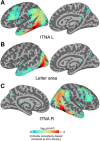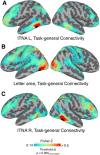Structural and functional connectivity of the inferior temporal numeral area
- PMID: 36587366
- PMCID: PMC10183753
- DOI: 10.1093/cercor/bhac492
Structural and functional connectivity of the inferior temporal numeral area
Abstract
A growing body of evidence suggests that in adults, there is a spatially consistent "inferior temporal numeral area" (ITNA) in the occipitotemporal cortex that appears to preferentially process Arabic digits relative to non-numerical symbols and objects. However, very little is known about why the ITNA is spatially segregated from regions that process other orthographic stimuli such as letters, and why it is spatially consistent across individuals. In the present study, we used diffusion-weighted imaging and functional magnetic resonance imaging to contrast structural and functional connectivity between left and right hemisphere ITNAs and a left hemisphere letter-preferring region. We found that the left ITNA had stronger structural and functional connectivity than the letter region to inferior parietal regions involved in numerical magnitude representation and arithmetic. Between hemispheres, the left ITNA showed stronger structural connectivity with the left inferior frontal gyrus (Broca's area), while the right ITNA showed stronger structural connectivity to the ipsilateral inferior parietal cortex and stronger functional coupling with the bilateral IPS. Based on their relative connectivity, our results suggest that the left ITNA may be more readily involved in mapping digits to verbal number representations, while the right ITNA may support the mapping of digits to quantity representations.
Keywords: brain connectivity; numerical cognition; object processing; occipitotemporal cortex; ventral stream.
© The Author(s) 2022. Published by Oxford University Press. All rights reserved. For permissions, please e-mail: journals.permission@oup.com.
Figures









References
-
- Allison T, McCarthy G, Nobre A, Puce A, Belger A. Human extrastriate visual cortex and the perception offaces, words, numbers, and colors. Cereb Cortex. 1994:4:544, 6026–554. - PubMed
Publication types
MeSH terms
Grants and funding
LinkOut - more resources
Full Text Sources

